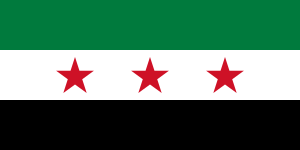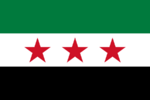Flag of Syria facts for kids
Syria has used two main flags since 2011 because of the Syrian civil war. One flag, with red, white, and black stripes, was used by the government led by Bashar al-Assad. This flag was first used by the United Arab Republic. The other flag, with green, white, and black stripes, is called the "Independence flag." It was first used by the First Syrian Republic. Groups opposing the government, like the Syrian National Coalition, used this flag. On December 8, 2024, the opposition took control of Damascus, the capital city. President Assad then left the country. After this, the "Independence flag" became the official flag of Syria. It is now used by the Syrian parliament, the new Syrian transitional government, and at Syrian embassies around the world.
Contents
Syrian Opposition Flag
 |
|
| Adopted | In de facto use from 8 December 2024 |
|---|---|
| Design | A horizontal triband of green, white, and black, with three red five-pointed stars on the white band |
During the civil war, groups opposing the Syrian government, like the Syrian National Council, started using a changed version of the "Independence flag." This flag was first used in 1932. They began using it widely in late 2011 to show they were different from the government.
The opposition chose this flag because it was used when Syria first became independent from France. Khaled Kamal, an official from the Syrian National Council, said this flag now stands for freedom and the end of Bashar al-Assad's rule. This flag was mainly seen in areas controlled by the Syrian National Coalition.
Historic Flags of Syria
Kingdom of Syria (1920)
Before 1918, Syria used the Ottoman flag. After the Ottomans left in 1918, Syria adopted the Faysal flag. This flag was also known as the Flag of the Arab Revolt. It was used during the 1916–1918 Arab Revolt against the Ottomans. This flag was the first to use the green, red, white, and black colors. These colors are found in most Syrian flags that came after.
The colors on this flag had special meanings. White stood for the Umayyad period in Damascus. Green was for Caliph Ali. Red was for the Khawarij Islamic movement. Black was for the Islamic prophet Muhammad. Another idea is that the horizontal colors stood for the Abbasid (black), Umayyad (white), and Fatimid (green]] Caliphates. The red triangle was for the Hashemite family.
Under the Arab Kingdom of Syria, the Faysal flag was changed. A white 7-pointed star was added to the red triangle. This flag was used for only about four months in 1920. Then, France took control of Syria.
French Mandate Flags (1920–1932)
When the French arrived in Syria, the Faysal flag was no longer used. General Henri Gouraud, the French High Commissioner, introduced a new flag on July 24, 1920. This flag was blue with a white crescent. It was based on an older flag and meant "love of peace."
This flag was used until September 1, 1920. After that, Syria was divided into different areas, and each got its own flag. On June 22, 1922, Gouraud created the Syrian Federation. This federation used a green-white-green flag with a small French flag in the corner. This same flag was used when the federation became the State of Syria in 1925. It remained in use until Syria became a republic in 1930.
Independence Flag
French Mandate and Independence (1930–1958, 1961–1963)
The flag for the new Syrian Republic was decided in its 1930 constitution. This constitution was written by a group led by Ibrahim Hananu. The French authorities at first did not want to approve it. But after public protests, they agreed with some changes.
On May 14, 1930, the French High Commissioner approved the "Constitution of the Syrian Republic." Article IV of this constitution described the flag: "The Syrian flag will be as follows: length double width, and is divided into three parallel and equal colours, the highest green, white then black, that the white section contains in a straight line three red five-pointed stars."

The green color on the flag stood for the Rashidun. White represented the Umayyads, and black symbolized the Abbasids. At first, the three red stars stood for three areas of Syria: Aleppo, Damascus, and Deir ez-Zor. In 1936, more areas joined Syria. So, the stars' meaning changed. The first star represented Aleppo, Damascus, and Deir ez-Zor. The second star was for Jebel Druze. The third star was for Sanjak of Latakia.
This flag became a symbol for Syrians who wanted to be free from France. Black stood for the hard past, white for a hopeful future, and red for the sacrifices needed to get there. Syria gained independence on April 17, 1946, and this flag was adopted. It was used until 1958, when Syria joined with Egypt to form the United Arab Republic. After this union ended in 1961, the independence flag was brought back. This was to show that Syria was separate from the failed union.
Ba'athist Flags
 |
|
| Name | Flag of United Arab Republic (1958–1961) Flag of Syrian Arab Republic (1980–2024) |
|---|---|
| Use | National flag and ensign |
| Proportion | 2:3 |
| Adopted | 22 February 1958, abandoned on 28 September 1961; readopted on 30 March 1980 |
| Design | A horizontal tricolour of red, white, and black; charged with two green stars at the centre. |
The flag of Ba'athist Syria was first used in 1958. It represented Syria as part of the United Arab Republic with Egypt. It was used until 1961 and then brought back in 1980. This red, white, and black flag has been used in different Arab unions involving Syria. Even though Syria is not part of a union anymore, this flag showed Syria's wish for Arab unity.
This flag became linked to the Ba'ath Party and the government of Bashar al-Assad during the Syrian civil war. After the fall of the Assad regime in 2024, this flag is no longer in use.
The Ba'athist Syrian flag is described in Article 6 of the Constitution of Syria. It says:
The flag of the Syrian Arab Republic has four colors: red, white, and black, with two green stars, each with five points. The flag is a rectangle, with its width being two-thirds of its length. It is divided into three equal rectangles of the same length. The top one is red, the middle is white, and the bottom one is black. The two green stars are in the middle of the white rectangle.
This flag is based on the Arab Liberation Flag. That flag had black, green, white, and red colors. These colors represented four important Arab dynasties: Abbasids, Faṭimids, Umayyads, and Hashimites.
Gamal Abdel Nasser, the president of Egypt, first adopted the two-star flag for Syria in 1958. This was when the United Arab Republic was formed. The flag changed from the older independence flag to create a stronger Arab identity. The new flag used the red-white-black stripes from the Egyptian revolutionary flag. The stars changed from red to green to show pan-Arab colors. The two stars stood for Egypt and Syria.
After Syria left the United Arab Republic in 1961, the previous independence flag was used again. This was to show Syria was no longer part of the failed union.
After a government change in 1963, a new flag was adopted on March 8, 1963. It was used until 1972. In 1963, the same political group also came to power in Iraq. Syria and Iraq tried to form a new union with Egypt. This union did not happen, but both Syria and Iraq adopted a new flag. This flag was similar to the United Arab Republic flag, but it had three stars instead of two. The three stars represented Egypt, Syria, and Iraq. They also stood for three ideas of the Ba'ath Party: unity, freedom, and socialism.
President Hafez al-Assad adopted another new flag on January 1, 1972. This was when Syria joined Egypt and Libya in the Federation of Arab Republics. The green stars were replaced by the Hawk of Quraish, a symbol of an important Arab tribe. This flag was used during the Yom Kippur War in 1973. The Federation ended in 1977, but Syria kept using the flag for three more years. On March 29, 1980, this flag was replaced by the two-star flag again. This was to show Syria's continued commitment to Arab unity.
List of Flags of Syria
This section shows different flags that have been used in Syria.
National Flags
-
Flag of the United Arab Republic (1958–1961)
-
Flag of the Syrian Arab Republic (1963–1972)
-
Flag of the Syrian Arab Republic (1980–2024)
Presidential Flags
Since 1980, Syria has not had a special presidential flag.
| Flag | Date | Use | Description |
|---|---|---|---|
 |
1972–1980 | Presidential flag of Syria | A flag with red, white, and black stripes, and the old symbol of Egypt. |
 |
1963–1972 | Presidential flag of Syria | A flag with red, white, and black stripes, and 3 dark green stars. |
 |
1958–1961 | Presidential flag of Syria | A flag with red, white, and black stripes, and 2 dark green stars. The colorful symbol of Egypt is in the top-left corner. |
 |
1941–1958, 1961–1963 | Presidential flag of Syria | A flag with dark green, white, and black stripes, and 3 red stars. |
Royal Flags
Military Flags
| Flag | Date | Use | Description |
|---|---|---|---|
 |
?–2024 | Flag of the Chief of the General Staff | |
 |
?–2024 | Flag of the Ministry of Defense | |
 |
1946–2024 | Flag of Syrian Armed Forces | The flag of Syria with the symbol of the Syrian Armed Forces in the top left corner. It says "Homeland Honor Devotion" and "Syrian Arab Army." |
 |
1945–2024 | Flag of Syrian Army | A green flag with the army's symbol in the middle. |
 |
1950–2024 | Flag of Syrian Navy | A blue flag with the navy's symbol in the middle. |
 |
post-2007–2024 | Flag of Syrian Air Force | A turquoise flag with their badge in the middle. |
| Until 2024 | Flag of the National Defence Forces |
Ensigns Flags
| Flag | Date | Use | Description |
|---|---|---|---|
 |
post-2007-2024 | Flag of Syrian Air Force Ensign | An almost gray flag with the Syrian flag in the top left and the air force symbol in the middle. |
Images for kids
-
Flag of Ba'ath Party
See also
 In Spanish: Bandera de Siria para niños
In Spanish: Bandera de Siria para niños
- National symbols of Syria
- Coat of arms of Syria
- Pan-Arab colors
- Flag of the Arab Revolt
- Flag of Egypt
- Flag of Iraq
- Flag of Jordan
- Flag of Kuwait
- Flag of Palestine
- Flag of Sudan
- Flag of the United Arab Emirates
- Flag of Yemen


































































































